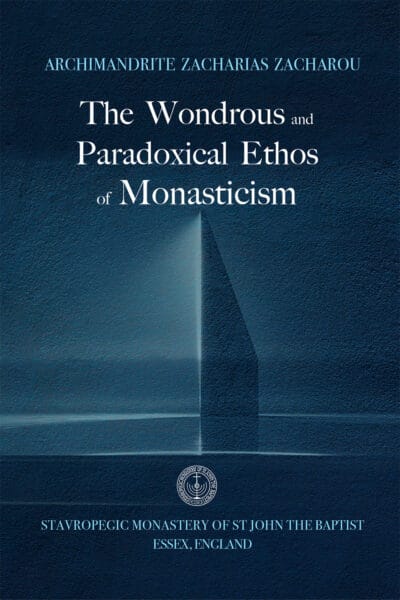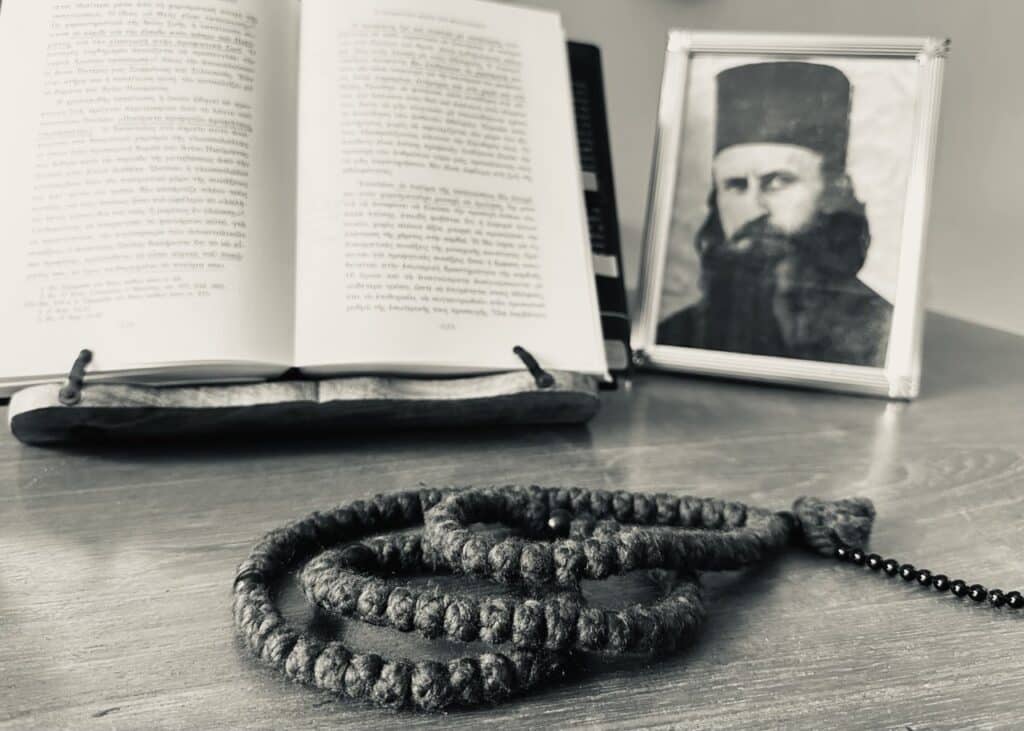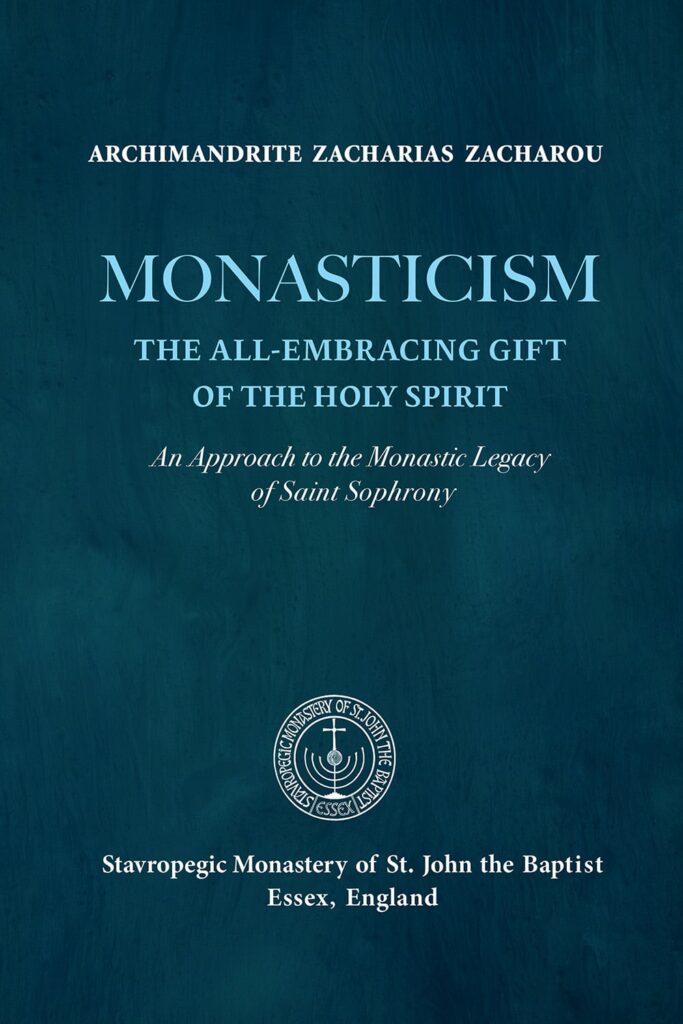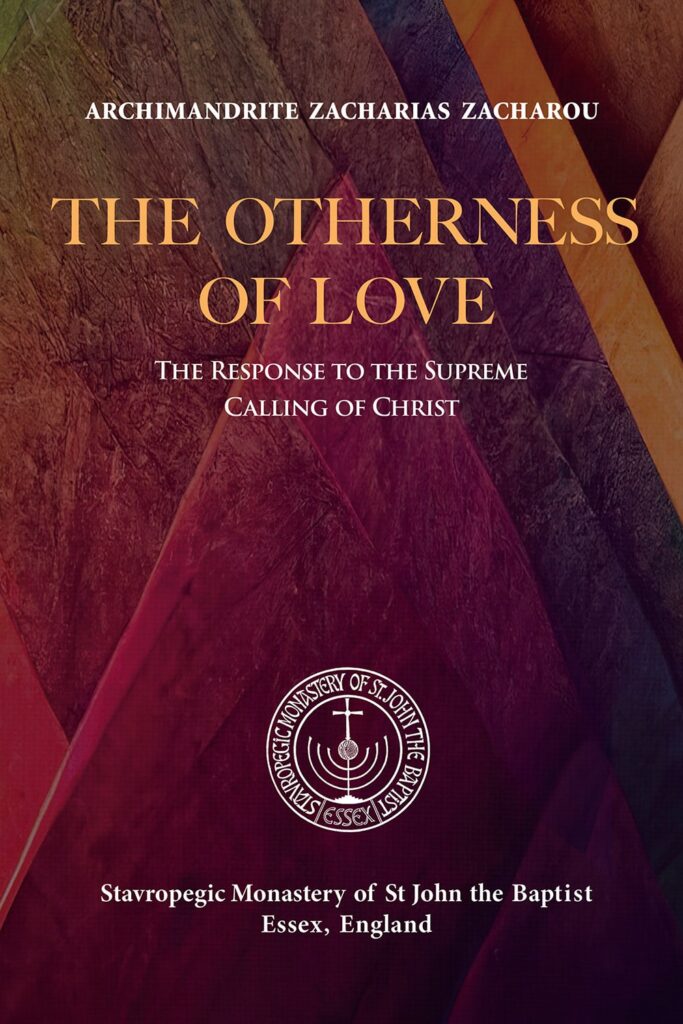Christian perfection exceeds human measures. It is not an endowment of our created nature but a divine gift, a grace of the Holy Spirit.1Archimandrite Sophrony (Sakharov), We Shall See Him as He Is, trans. Rosemary Edmonds, (Tolleshunt Knights, Essex: Stavropegic Monastery of St John the Baptist, 2023) p. 108. This perfection was revealed in the human nature of Christ, which He assumed from the Holy Virgin. Within the confines of this earthly life it remains unattainable. Nevertheless, God desires this perfection for His creature and commands it: ‘Be ye therefore perfect, even as your Father which is in heaven is perfect.’2Matt.5:48. See also Archimandrite Zacharias (Zacharou), Christ, Our Way and Our Life: A Presentation of the Theology of Archimandrite Sophrony, (Tolleshunt Knights, Essex: Stavropegic Monastery of St John the Baptist, 2023), p. 153.
Saint Theodore the Studite, the great father and teacher of monks, speaks with enthusiasm about the all-embracing gift of monasticism and calls it the ‘third grace’.3Saint Theodore the Studite, Epistle 165, PG 99,1524CD. The first grace was the law of Moses. The second grace is the ‘grace for grace’, which we all received from the fulness of Christ, according to the words of the Evangelist John.4John 1:16.
Finally, the third grace is the monastic pattern of life, given to man from above, and experienced as a heavenly conversation upon earth, as an imitation of the life of the angelic realm, which serves the one and only will of God. By acquiring this grace, that which essentially exceeds the limits of the earth is realised in history. The presence of the Kingdom of God is experienced ‘come with power’ from this life.5Mark 9:1.
At the dawn of the third millennium of Christianity, Orthodox monasticism faces extreme challenges arising from man’s aspiration for complete autonomy from God and the replacement of his sanctification by the construction of the Superman and the Posthuman. The modern world seeks absolute freedom through the created mind, which is inherently and hopelessly limited by corruption and death. The monk, on the other hand, seeks spiritual freedom, which builds in him a pure heart and makes him receptive to the illuminations of the grace of the Holy Spirit. Only then is man truly liberated from the threat of corruption and death by becoming a partaker of the uncreated wisdom and almighty energy of God.
In this context, we dare to say that today, more than ever, the monk is indeed like a small drop of water moving against a raging torrent. Cut off from everyone, but strengthened by the divine presence, he resists the current of mass apostasy and oblivion of God.
A great obstacle to this superhuman struggle is the temptation of secularisation, which paralyses the monk and renders him incapable of being a witness to divine otherness in the world. We recall the words of the late Metropolitan John of Pergamon, who said: ‘If even the monks lose their pattern of life “outside the camp of this world”, we will not be able to find this charismatic witness anywhere, because the monks are the only hope that the faithful living in the world have for this witness.’
Monks are also leaves of the tree called mankind, and the course of the world inevitably influences, to some extent, the character of life in all monasteries. From this point of view, great care must be taken with technology, which has inevitably infiltrated all the monasteries today. Especially concerning the use of the internet, even greater discretion and fear of God are necessary since, through a single cable the whole world can now intrude into the monk’s cell, this sacred space that should be exclusively dedicated to insatiable converse with the Bridegroom Christ. A sinful attachment to the use of technology can lead to the total desolation of monastic life.
Another challenge of the times is the fact that the psyche of people today is generally weakened, and each new generation of monks proves to be both organically and psychologically weaker than the previous one. Chronologically, our generation is closer to the Second Coming of Christ than any other. This however implies that it is in greater anguish and need of redemption than any other, according to the words of Christ, ‘Nevertheless when the Son of man cometh, shall he find faith on the earth?’6Luke 18:8. What are the great afflictions that so strongly torment our generation? Foremost among them is pride, the darkening of the mind and its captivity to the evil spirit; then despair and the multitude of involuntary sufferings that accompany it; and finally, utter despondency and spiritual paralysis.7Archimandrite Zacharias (Zacharou), Christ, Our Way and Our Life, p. 315.
In the face of challenges, the most ‘sure and steadfast’8Heb. 6:19. anchor for monks is to be incorporated into the current of Holy Tradition so that the disastrous temptation of autonomy may be avoided as well as the tendency to an idiorrhymic way of life, which kills the spirit. This incorporation is achieved through the mystery of obedience to an Elder, a mystery which Saint Sophrony referred to as ‘sacred and ineffable’.9Archimandrite Sophrony (Sakharov), Truth and Life, (Tolleshunt Knights, Essex: Stavropegic Monastery of St John the Baptist, 2016), p. 83. Obedience, for those who embrace it, is the cornerstone of monastic life. It makes monasticism truly prophetic, bearing witness to the indescribable humility of Christ.10Archimandrite Sophrony (Sakharov), Saint Silouan the Athonite, trans. Rosemary Edmonds, (Tolleshunt Knights, Essex: Stavropegic Monastery of St John the Baptist, 2023), p. 431.
If the sacred relationship with the Elder is strong, stable, and healthy, then inspiration becomes inexhaustible and the obedient monk never knows despondency as he is continuously within the current of divine life. He undergoes unceasing changes in his heart, and is continually enriched with new ascents in his uprush towards God. He is the ‘blessed man whose strength is in God; He has set ascents in his heart.’ In this way, monastic life is experienced as the tender care of God. Then, even if all the forces of the enemy assail the monk, they have no power over him, nor can they harm him because the sacred mystery at work in his heart is mightier than their strength. 11Archimandrite Zacharias (Zacharou), Monasticism: The All-Embracing Gift of the Holy Spirit, p. 72.
Monasticism
The All-Embracing Gift of the Holy Spirit. An Approach to the Monastic Legacy of Saint Sophrony
The true disciple can be likened to an eagle who, with the wings of obedience, safely ascends to spiritual heights, calmly observing the distance that separates him from the earth while contemplating the beauty of the noetic Sun, the Lord Jesus. Saint Sophrony writes:
‘Monasticism above all means purity of the mind, which is unattainable without obedience. That is why there can be no monasticism without obedience.’ 12Archimandrite Zacharias (Zacharou), Monasticism: The All-Embracing Gift of the Holy Spirit, p. 72.
Essentially, monasticism is neither the beautiful and solemn services nor the typikon nor the buildings. Monasticism is the relationship of the obedient monk with his Elder.13Archimandrite Zacharias (Zacharou), Monasticism: The All-Embracing Gift of the Holy Spirit, p. 71-72. See also by the same author, The Otherness of Love, p. 154, 161-162. When this relationship is governed by love and distinguished by its transparency and fidelity, it serves the eternal relationship with Christ. Then obedience becomes the key that reveals the mystery of the ways of the Spirit and the depths of the words of the Holy Scriptures. As Saint John of the Ladder declares: ‘Even though the one giving the commandment is visible, the hand that commands him is invisible.’14See Saint John Climacus, The Ladder of Divine Ascent, Step 26:111, p. 205. See also Monasticism, p. 45.
Saint Symeon the New Theologian has expressed this law of the Spirit with great accuracy, observing: ‘God did not create masters and slaves but fathers and sons, who in turn also become fathers,’15See Saint Symeon the New Theologian, Τὰ Εὑρισκόμενα διηρημένα εἰς δύῳ (Discovered Writings in Two Sections), Μετάφραση Διονυσίου Ζαγοραίου, Ἐκ τῆς τυπογραφίας Νικολάου Δαμιανοῦ, Σῡρος 1866, 24, p. 130. and the heart of these sons proves faithful to the end.16Archimandrite Zacharias (Zacharou), The Otherness of Love, pp. 89, 137 Monastic life is a culture that is ‘not of this world’. It is not a human invention. It is the Gospel unadulterated, the pure imitation of Christ to the end. If monasticism is not deeply rooted in the evangelical truth, it does not prosper and is in danger of becoming ‘another of the half-blind powers of this world’.17Archimandrite Sophrony (Sakharov), On Prayer, trans. Rosemary Edmonds, (Tolleshunt Knights, Essex: Stavropegic Monastery of St John the Baptist, 2007), pp. 108-109. See also Archimandrite Zacharias (Zacharou), The Otherness of Love, p. 90.
The ‘exodus’ from the world gives monasticism an apocalyptic character and places it in an eschatological perspective. It creates favourable conditions by delivering man from the many cares of life and inspiring steadfast devotion to the commandments of Christ. This eschatological element of monasticism is the centrifugal force that takes the monk out of the earth’s gravitational field, the dominion of the law of sin, and helps him to turn from the corruptible things of this world to things incorruptible and heavenly.
Along with all the challenges that monasticism faces today, it also enjoys great blessings and special favour from the most Holy institution of the Church, which is well-pleased to share in the monks’ desires whilst also defending their culture.
The beginning of the twenty-first century was marked by a series of canonisations of holy ascetics, the majority of whom were bearers of the hesychastic tradition of Mount Athos who imparted an invaluable testimony.
Through them the torch of the all-inclusive gift of monasticism was passed on to Europe and the New World. Moreover, all these modern Saints became a pole of attraction for the monks of the East, especially from the countries where totalitarian regimes forcibly destroyed and almost completely emptied the monasteries, so that the monks were cut off for decades from the age-old Monastic Tradition. Many of them are now thirstily seeking contact and communion with the wealth of Athonite monasticism.
There is a historical precedent to this phenomenon, when in the 14th century the spirit of Hesychasm, with Saint Gregory Palamas as its main exponent, expanded and spread rapidly not only within the Byzantine Empire but also throughout the Orthodox world. In particular, through the activity of Saint Gregory of Sinai and his disciples, the monks Theodosius and Euthymius of Tarnovo, and with the affectionate protection and blessing of the Mother Church of Constantinople, monastic brotherhoods were created in the Balkan region, where for the first time monks of various nationalities settled in the same monasteries. The true reason for this was the spiritual unity that existed between them. They were united by the desire for hesychastic prayer, which acted as an antidote to the passion of nationalism.
By extension, we see a greater hope arising for the unity of all Christians through the beneficial influence of the Hesychasm, which is the heart of the Orthodox ascetic tradition. Unity comes as a natural consequence when the commandments of Christ become the only law of man’s existence. In this perspective, Hesychasm proves to be the ‘innermost body’ of the Body of the Church, the ‘salt of the earth’18Matt.5:13. and the ‘sustaining power’19Cf. 2 Thess. 2:6-7. that preserves the world.
In epochs during which an indiscriminate zeal fragmented and split off many pious monks and Christians from the bosom of the Church, the modern and recently canonised Hesychastic Fathers themselves set forth the principles of sound ecclesiology, since they bore within themselves information from above about Christ’s Holy Church as the only ark of salvation. Although they themselves had risen to the heights of divine vision, they always kept in the highest honour the Shepherds of the Church and their martyric mission in the world, thus demonstrating the complementarity of the institution and the gift, and their unbreakable unity in one life, within the bosom of the One, Holy and sanctifying Church of Christ.
This profound respect of the ascetics for the Shepherds of the Church shows a healthy spiritual attitude. Already since the time of Anthony the Great, we see all the monks going out in procession to meet Athanasius the Great. The case of Saint Mary of Egypt, who led an extremely hermitic life, is very impressive and is of great benefit to us, yet in her meeting with the holy Abba Zosima she showed a paradoxical concern for Christians and the Church in the world: ‘How do the Christian people live? How are the Emperors? How is the Church shepherded?’20Cf. Saint Sophronios, Patriarch of Jerusalem, The Life of Saint Mary of Egypt, trans. Mother Mary, (Bussy-en-Othe, France: The Orthodox Monastery of the Veil of Our Lady, 2020), p. 12.
In the persons of the holy ascetics the ontological unity of all believers in a Body, of which we are all members, is confirmed, and furthermore the Philokalic doctrine that the true monk is ‘one who is separated from all and united with all’.21Evagrios the Solitary, ‘On Prayer: One Hundred and Fifty Three Texts’, in The Philokalia, translated by G.E.H. Palmer, Philip Sherrard and Kallistos Ware, (London & Boston: Faber & Faber, 1979), vol. 1, 124, p. 69.
According to Saint Sophrony, we would not be able to deal with the challenges of the modern world without the teaching of Saint Gregory Palamas. The hesychastic life provides a way out for our times, in which man longs for bliss and pleasure and is attracted to novelty. Man’s desires have taken a false orientation, and he seeks light where darkness reigns, that is, in the pleasure of the senses. The young in particular, if they had even a glimpse of the beauty and humble love of God, would know true bliss and would rejoice in the supernatural delight, the delight of the Spirit. By faith, they would perceive divine otherness and rejoice in tasting true joy.22Archimandrite Zacharias (Zacharou), The Otherness of Love, p. 50.
The Otherness of Love
The Response to the Supreme Calling of Christ
Before the true rejoicing of the heart and not of the senses, the mask of worldly ‘joy’ is removed and its deception is revealed. Having tasted the ‘fragrance of life unto life’, man recognises the ‘odour of death unto death’,23Cf. 2 Cor. 2:16. and not only avoids it, but seeks with desire the One who is not bound by death, the Giver of the abundance of life.24Archimandrite Zacharias (Zacharou), The Otherness of Love, p. 51.
The hesychast monk actually understands that God has ‘clarified the nature of beings’. He knows what the tragedy of man’s nature is when he is cut off from the life-giving energy of God, and what that nature can become in the communion of grace.
That which possesses the minds of our saints is undoubtedly this vision of the ‘greater love’ of Christ, Who inverts the pyramid of all created being and places Himself at its inverted summit, taking upon Himself the sin of the world and bearing the condemnation to death that has wounded men. It is this ultimate perfection of Christ’s love unto the end that provokes within the monk a response of gratitude and love that enables him to go out from the camp of this world so he may meet the Bridegroom coming forth from Heaven. Hastening towards the depths of the inverted pyramid of the world, ‘beneath every creature’, the monk is united with the New Adam, the author and finisher of our faith, Jesus Christ, and then with an enlarged heart ‘he prays for all Adam as for himself’.
‘Angels are a light for monks, and the monastic life is a light for all men.’25Cf. Saint John Climacus, The Ladder of Divine Ascent, Step 26:31, p. 195. This light is the knowledge of the way of the Lord and His commandments, which is kept on earth in the bosom of the Church through the way of monasticism. Only the perfect knowledge of this way leads to the universal enlargement of the human hypostasis, which by grace becomes a mediator between God and creation. This divine intercession becomes a power that upholds the world.
The greatest and most valuable contribution of monasticism consists in the fact that it preserves the humility of Christ, who placed Himself under every creature and died a painful death ‘outside the camp’, utterly despised, in order to bring everyone to the Heavenly Father. And this offering of the monk is beneficial to the whole world today for the following reason:
The ontological unity of humanity is such that every separate individual overcoming evil in himself inflicts such a defeat on cosmic evil that its consequences have a beneficial effect on the destinies of the whole world. On the other hand, the nature of cosmic evil is such that, vanquished in certain human hypostases it suffers a defeat the significance and extent of which are quite disproportionate to the number of individuals concerned.26Saint Silouan the Athonite, pp. 221-222.
In the Book of Acts it is stated that, after seeing the Risen Lord, the holy Apostles became witnesses of His Resurrection ‘with great power’.27Acts 4:33. Likewise, those monks who possess the power of the great science of monasticism also become the living witnesses of the eternal truth of the Gospel, giving assurance in man’s heart of salvation.
Footnotes
- 1Archimandrite Sophrony (Sakharov), We Shall See Him as He Is, trans. Rosemary Edmonds, (Tolleshunt Knights, Essex: Stavropegic Monastery of St John the Baptist, 2023) p. 108.
- 2Matt.5:48. See also Archimandrite Zacharias (Zacharou), Christ, Our Way and Our Life: A Presentation of the Theology of Archimandrite Sophrony, (Tolleshunt Knights, Essex: Stavropegic Monastery of St John the Baptist, 2023), p. 153.
- 3Saint Theodore the Studite, Epistle 165, PG 99,1524CD.
- 4John 1:16.
- 5Mark 9:1.
- 6Luke 18:8.
- 7Archimandrite Zacharias (Zacharou), Christ, Our Way and Our Life, p. 315.
- 8Heb. 6:19.
- 9Archimandrite Sophrony (Sakharov), Truth and Life, (Tolleshunt Knights, Essex: Stavropegic Monastery of St John the Baptist, 2016), p. 83.
- 10Archimandrite Sophrony (Sakharov), Saint Silouan the Athonite, trans. Rosemary Edmonds, (Tolleshunt Knights, Essex: Stavropegic Monastery of St John the Baptist, 2023), p. 431.
- 11Archimandrite Zacharias (Zacharou), Monasticism: The All-Embracing Gift of the Holy Spirit, p. 72.
- 12Archimandrite Zacharias (Zacharou), Monasticism: The All-Embracing Gift of the Holy Spirit, p. 72.
- 13Archimandrite Zacharias (Zacharou), Monasticism: The All-Embracing Gift of the Holy Spirit, p. 71-72. See also by the same author, The Otherness of Love, p. 154, 161-162.
- 14See Saint John Climacus, The Ladder of Divine Ascent, Step 26:111, p. 205. See also Monasticism, p. 45.
- 15See Saint Symeon the New Theologian, Τὰ Εὑρισκόμενα διηρημένα εἰς δύῳ (Discovered Writings in Two Sections), Μετάφραση Διονυσίου Ζαγοραίου, Ἐκ τῆς τυπογραφίας Νικολάου Δαμιανοῦ, Σῡρος 1866, 24, p. 130.
- 16Archimandrite Zacharias (Zacharou), The Otherness of Love, pp. 89, 137
- 17Archimandrite Sophrony (Sakharov), On Prayer, trans. Rosemary Edmonds, (Tolleshunt Knights, Essex: Stavropegic Monastery of St John the Baptist, 2007), pp. 108-109. See also Archimandrite Zacharias (Zacharou), The Otherness of Love, p. 90.
- 18Matt.5:13.
- 19Cf. 2 Thess. 2:6-7.
- 20Cf. Saint Sophronios, Patriarch of Jerusalem, The Life of Saint Mary of Egypt, trans. Mother Mary, (Bussy-en-Othe, France: The Orthodox Monastery of the Veil of Our Lady, 2020), p. 12.
- 21Evagrios the Solitary, ‘On Prayer: One Hundred and Fifty Three Texts’, in The Philokalia, translated by G.E.H. Palmer, Philip Sherrard and Kallistos Ware, (London & Boston: Faber & Faber, 1979), vol. 1, 124, p. 69.
- 22Archimandrite Zacharias (Zacharou), The Otherness of Love, p. 50.
- 23Cf. 2 Cor. 2:16.
- 24Archimandrite Zacharias (Zacharou), The Otherness of Love, p. 51.
- 25Cf. Saint John Climacus, The Ladder of Divine Ascent, Step 26:31, p. 195.
- 26Saint Silouan the Athonite, pp. 221-222.
- 27Acts 4:33.





